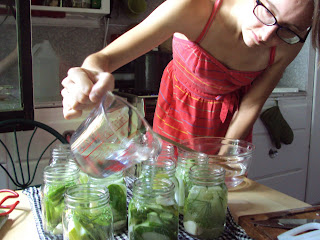"You can always pickle a cucumber but you can't cucumber a pickle"
Growing up my great aunt and uncle had a cucumber crop behind their house and we were in charge of picking the best little cucumbers unbeknownst to our little child hands that the cukes had prickles. At least that's how I remember it...
When we last visited the garden we found out that some of the cucumbers got out of hand and grew quite large. We picked about eight of them along with some dill heads with the hopes to try making our own pickles. My wonderfully talented friend Rebecca from Replicca Clothing came over to help with the whole process as well as take these awesome pictures.
 | |
| I got a few boxes of jars from a great second hand store called Bibles for Missions Thrift Store for under $20. |
 | |
| We began packing the cukes, dill heads, and garlic into the jars |
 |
| We didn't boil it first either. I just love the bright greens in these pictures. |
 |
| We used a very basic brine of vinegar, kosher salt, and water. |
Anethum Graveolens
I can confidently say that dill is one of the most delicious herbs in the entire world. The plant itself is a feathery stalk with tiny yellow flowers. Dill has a very distinctive aroma that has been described as a faint aniseed. The taste is complex and it's similar to that of caraway, but has a tangy, grassy flavour to it along with a hint of lemon, pine and fennel.
The name Dill is derived from the Norse "dylla", meaning to lull or soothe. It has been used as a culinary and medicinal herb from the beginning of civilisation.
Dill has been known for it's medicinal properties and was used in ancient Egypt, first described in the Ebers papyrus (c. 1500 BCE), where it was an ingredient in a pain-killing mixture. The ancient Greeks are believed to have covered their eyes with the herb to induce sleep and Hippocrates wrote of a recipe for cleaning the mouth in which you rinsed with dill seed which had been boiled in white wine.
Ancient Romans considered dill good luck and believed that it had fortifying qualities. They thought it was an effective stimulant for gladiators who were given food covered with dill. They also used dill as part of wreaths and garlands to be worn about the head by their victorious heroes.
 |
| Lowering the jars in for the hot water bath |
Now we just have to patiently wait for the pickles to... pickle !

















